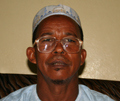Ajami in the Senegambia
by Fallou Ngom
Boubacar Diallo's Fula - Pulaar Community
Background about Fula - Pulaar
 Fuuta Jalon Fula is the variety of Fulfulde primarily spoken in the Republic of Guinea. It is also spoken in neighboring Senegal (particularly in the south), Guinea Bissau and The Gambia. Following are some linguistic features that distinguish Fuuta Jalon from the Fuuta Tooro variety (primarily spoken in northern Senegal) and the Fulakunda variety (primarily spoken in the region of Kolda in southern Senegal).
The morpheme "-aani" is the perfective negative morpheme in both Fuuta Tooro and Fulakunda, while the Fuuta Jalon variety uses the morpheme "-aali." The Fuuta Jalon
variety favors sequences of oral vowels followed by the velar nasal consonant "ŋ" word-finally (similar to Senegambian Mandinka), while the Fuuta Tooro and Fulakunda
varieties generally use sequences of oral vowels followed by either the alveolar nasal 'n' or the bilabial nasal 'm' in similar positions.
While none of these varieties is introduced in the public school system, their Latin-
based alphabets are now used in adult literacy programs in Senegambia, particularly in rural areas, by both government and non-government organizations. Best evidence
suggests that Ajami is not yet taken into account in formal literacy programs in the
region. In general, while the Latin script is more commonly used in urban and rural
areas where government and non-government literacy programs operate, Ajami continues to be the primary means of written communication in Muslim areas where these organizations have little presence. Because most Fulani people are Muslim, their linguistic varieties naturally exhibit strong lexical influences from Arabic.
Fuuta Jalon Fula is the variety of Fulfulde primarily spoken in the Republic of Guinea. It is also spoken in neighboring Senegal (particularly in the south), Guinea Bissau and The Gambia. Following are some linguistic features that distinguish Fuuta Jalon from the Fuuta Tooro variety (primarily spoken in northern Senegal) and the Fulakunda variety (primarily spoken in the region of Kolda in southern Senegal).
The morpheme "-aani" is the perfective negative morpheme in both Fuuta Tooro and Fulakunda, while the Fuuta Jalon variety uses the morpheme "-aali." The Fuuta Jalon
variety favors sequences of oral vowels followed by the velar nasal consonant "ŋ" word-finally (similar to Senegambian Mandinka), while the Fuuta Tooro and Fulakunda
varieties generally use sequences of oral vowels followed by either the alveolar nasal 'n' or the bilabial nasal 'm' in similar positions.
While none of these varieties is introduced in the public school system, their Latin-
based alphabets are now used in adult literacy programs in Senegambia, particularly in rural areas, by both government and non-government organizations. Best evidence
suggests that Ajami is not yet taken into account in formal literacy programs in the
region. In general, while the Latin script is more commonly used in urban and rural
areas where government and non-government literacy programs operate, Ajami continues to be the primary means of written communication in Muslim areas where these organizations have little presence. Because most Fulani people are Muslim, their linguistic varieties naturally exhibit strong lexical influences from Arabic.
Scroll down to see Community Image Gallery
Background information about Old manuscript
Linguistic features of Old manuscript
| << Previous | | 1 of 4 | | Next >> |
Old manuscripts
(Unknown)Boubacar Diallo holds an old manuscript in his living room, which he said was inherited from his great-grandfather, the author. He said that it is a collection of Arabic and Fuuta Jalon Ajami poems, and that the manuscript is over 100 years old. There are numerous such manuscripts among Fuuta Jalon Pular people which are jealously guarded by the most trusted person in the family.


